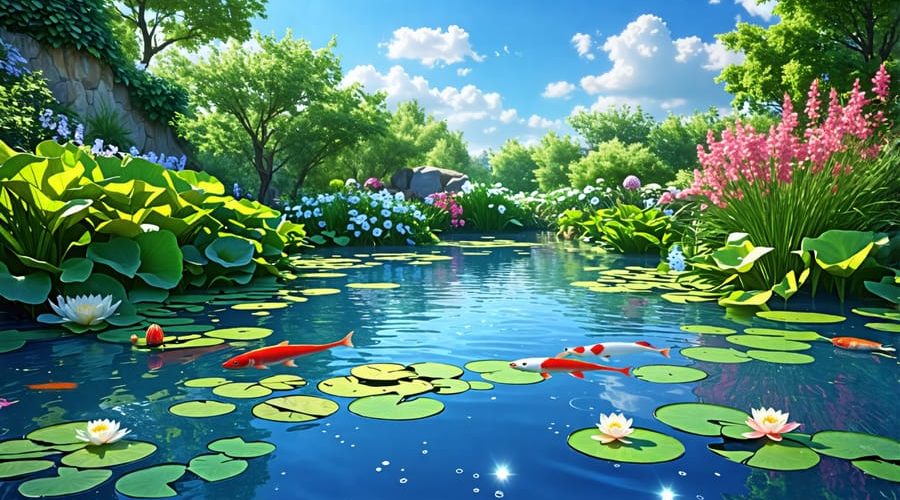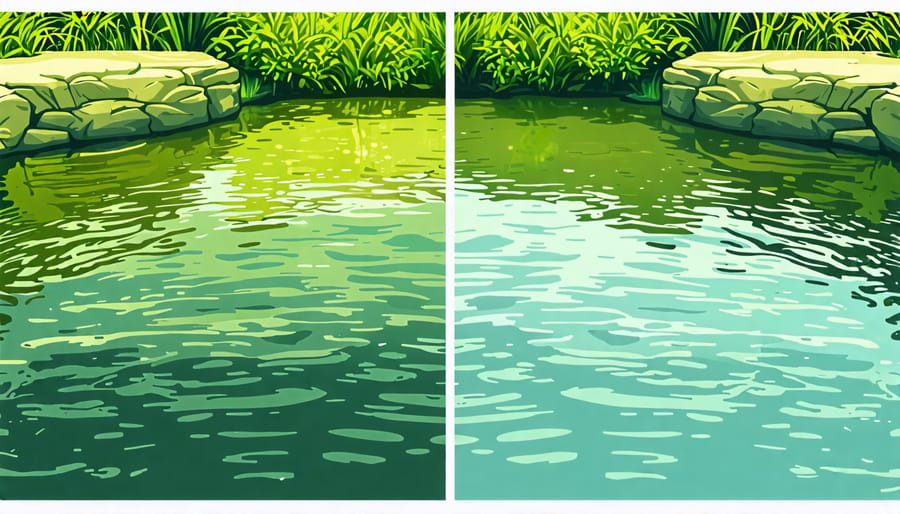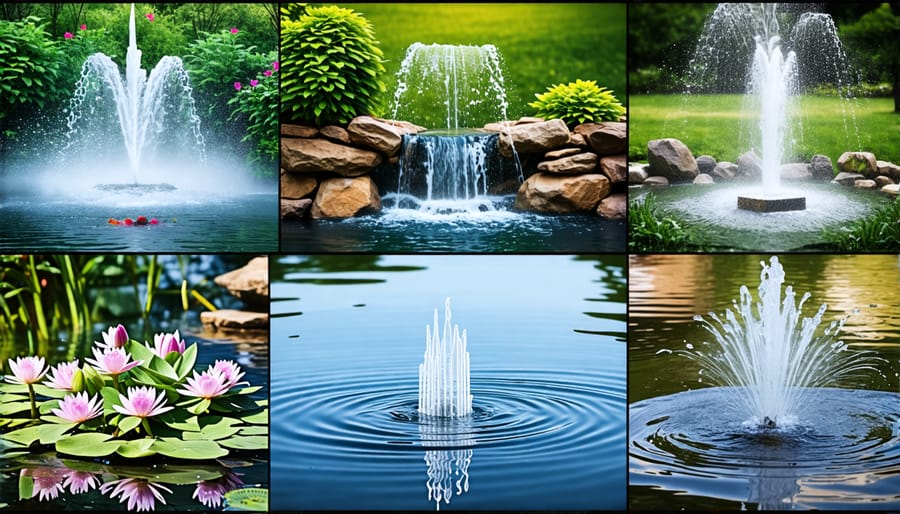
10 Essential Secrets to Keep Your Garden Pond Crystal Clear
Test and balance water chemistry weekly, aiming for a pH between 6.5-8.5, low ammonia and nitrites, and adequate oxygen levels. Aerate your pond using waterfalls, fountains, or pumps to improve water quality and prevent stagnation. Regularly skim off floating debris, vacuum accumulated sludge, and maintain an efficient filtration system sized for your pond volume. Proactively control algae by limiting nutrients, strategically planting shade-creating vegetation, and using safe, natural treatments like barley straw when needed.
Maintain Optimal Water Quality

Perform Regular Water Changes
Keeping your pond water fresh is essential for a thriving ecosystem. Aim to perform partial water changes every few weeks, replacing about 10-15% of the water each time. Use a pond vacuum or siphon to remove debris and dirty water from the bottom, targeting areas with excess sludge buildup. Refill with dechlorinated tap water or collected rainwater, avoiding drastic temperature changes that could shock fish.
When refilling, direct the new water flow towards the pond edges or rockwork to minimize disturbance. Take this opportunity to rinse any pond filters and skim out floating debris. Regularly replenishing a portion of the water helps dilute accumulated toxins, replenish beneficial minerals, and maintain optimal water chemistry. Consistency is key – set reminders and establish a routine that works for your schedule. Your pond inhabitants will thank you with their vibrant health and the water will sparkle with renewed clarity.
Choose the Right Filtration
Choosing the right filtration system is crucial for maintaining a healthy and clear garden pond. There are several types of pond filters available, each with its own advantages. Mechanical filters, such as skimmers and sieves, remove debris and solid waste from the water’s surface. Biological filters, like filter mats and media, provide a home for beneficial bacteria that break down harmful toxins. UV clarifiers use ultraviolet light to eliminate algae and improve water clarity.
When selecting a filter, consider the size of your pond, fish population, and desired maintenance level. For smaller ponds with fewer fish, a basic mechanical filter may suffice. Larger ponds or those with koi will benefit from a combination of mechanical and biological filtration. UV clarifiers are ideal for persistent algae issues or achieving crystal-clear water.
Don’t forget to factor in the flow rate and choose a filter that can turn over the entire volume of your pond at least once every hour. With the right filtration setup, you’ll spend less time cleaning and more time enjoying your beautiful, thriving water garden. Remember, investing in quality filtration from the start will save you headaches down the road!

Control Algae Growth
Algae growth is a common challenge for pond owners, often caused by excess nutrients, slow water movement, and ample sunlight. Fortunately, there are several effective strategies to keep algae in check and maintain a balanced ecosystem. One natural method is adding barley straw to your pond. As it decomposes, barley straw releases compounds that inhibit algae growth without harming plants or fish. Simply place a loosely packed ball of straw in the pond, using about 2.5 ounces per 1,000 gallons of water, and replace it every 4-6 months.
UV clarifiers are another powerful tool, using ultraviolet light to eliminate free-floating algae. As water passes through the unit, the UV light destroys algae cells, resulting in clearer water within a few days. When choosing a UV clarifier, ensure it’s sized appropriately for your pond volume and flow rate.
Introducing natural algae predators, such as tadpoles, snails, and algae-eating fish, can also help control growth. White cloud mountain minnows, mosquitofish, and certain species of plecos are all excellent choices. Aim for about one algae-eating fish per 25 square feet of pond surface.
Lastly, regular maintenance, such as removing debris, avoiding overfeeding fish, and ensuring proper filtration, goes a long way in preventing excess nutrients that fuel algae growth. By implementing a combination of these strategies tailored to your pond’s specific needs, you’ll be well on your way to enjoying a clear, algae-free oasis.
Maintain Proper Fish Population
Maintaining a proper fish population is essential for the health and balance of your garden pond. The number and type of fish your pond can support depends on its size. A general rule of thumb is to have no more than 1 inch of fish per 10 gallons of water. For example, a 500-gallon pond could house around 50 inches of fish.
When selecting fish species, consider their adult size and compatibility. Goldfish and koi are popular choices, but they can grow quite large. Smaller species like white cloud mountain minnows, neon tetras, and mosquitofish are suitable for more compact ponds. Avoid overstocking with too many large fish, as this can lead to excess waste production and poor water quality.
Introduce new fish gradually to allow the pond’s ecosystem to adjust. Monitor fish behavior and health regularly, and remove any sick or dead fish promptly to prevent disease spread. If you notice signs of overcrowding, such as stunted growth or frequent aggression, consider rehoming some fish or upgrading to a larger pond.
By maintaining an appropriate fish population for your pond’s size and capacity, you’ll create a thriving, visually appealing underwater world while keeping the water clear and healthy.
Provide Healthy Fish Diet
To ensure your pond fish thrive, feed them a balanced diet that mimics their natural food sources. High-quality commercial fish foods containing a blend of plant and animal-based ingredients are ideal. Koi and goldfish benefit from floating pellets, while smaller fish prefer flakes or crumbles. Supplement their diet with occasional treats like bloodworms, brine shrimp, or leafy greens such as lettuce and spinach. Avoid overfeeding, as uneaten food can pollute the water. Feed fish only what they can consume within 5 minutes, 2-3 times daily during warmer months. In colder weather, reduce feeding frequency as fish metabolism slows down. Regularly observe your fish during feeding time to monitor their health and adjust portions accordingly. By providing a nutritious diet and following best feeding practices, you’ll help your pond fish stay vibrant, active, and resistant to diseases.
Keep Pond Well Aerated
Keeping your pond well aerated is essential for maintaining a healthy aquatic ecosystem. Dissolved oxygen plays a vital role in supporting fish, plants, and beneficial bacteria. Without adequate oxygen levels, your pond inhabitants may struggle to thrive, and water quality can deteriorate rapidly.
To ensure your pond stays properly oxygenated, consider installing an aeration system. Fountains and waterfalls not only add visual appeal to your water garden but also help to circulate and oxygenate the water as it cascades back into the pond. The splashing action increases the surface area exposed to air, allowing for greater oxygen exchange.
Another effective option is using a diffuser or air stone system. These devices release tiny bubbles from the bottom of the pond, creating a constant stream of oxygen-rich water rising to the surface. As the bubbles burst, they agitate the water surface, promoting gas exchange and improving overall pond aeration.
Whichever method you choose, be sure to select a system that’s appropriately sized for your pond’s volume and depth. Proper aeration not only keeps your fish happy and healthy but also helps to break down organic matter, reduce algae growth, and maintain crystal-clear water for your enjoyment.
Manage Aquatic Plants
When it comes to choosing the ideal plant species for your garden pond, consider a mix of submerged, marginal, and floating plants. Submerged plants like hornwort and anacharis provide oxygen and help control algae growth. Marginal plants such as cattails, rushes, and irises add visual interest and help filter the water. Floating plants like water lilies and water lettuce provide shade and a resting spot for wildlife.
To keep your aquatic plants thriving, pay attention to their placement. Submerged plants should be anchored to the bottom of the pond, while marginal plants prefer shallow areas or shelves around the edges. Floating plants can drift freely on the surface. Avoid overcrowding by following spacing recommendations for each species.
Regular pruning is essential to maintain plant health and prevent them from overtaking the pond. Remove any dead, damaged, or yellowing leaves promptly to avoid decay. Thin out excess growth as needed, especially if plants are blocking sunlight or impeding water flow. For water lilies, prune spent flowers and leaves at the base of the stem.
Dividing and repotting aquatic plants every few years helps rejuvenate them and control their spread. Do this in early spring or fall when the plants are dormant. Gently remove the plant from its container, separate the roots, and replant the divisions in fresh soil. This process also allows you to inspect the roots for any signs of damage or disease.
By carefully selecting, placing, and maintaining your aquatic plants, you’ll create a stunning and balanced ecosystem that enhances the beauty and health of your garden pond.

Perform Seasonal Maintenance
As the seasons change, so should your garden pond care routine to keep the ecosystem healthy and thriving year-round. In spring, remove any debris that accumulated over winter, clean the filters, and check equipment. Gradually feed fish as the water warms. Plant hardy marginal plants in the shallows.
Summer is prime pond time. Feed fish regularly, but avoid overfeeding which can cause algae blooms. Remove dying leaves and spent flowers. Run filters and pumps continuously. Top off water levels as needed. Skim out floating debris. Monitor water quality and fish health weekly.
Fall is time to prep the pond for winter dormancy. Stop feeding fish once temperatures drop below 50°F. Trim dead foliage from plants. Remove leaves and debris frequently to avoid buildup. Maintain equipment until temperatures reach freezing.
In cold climates, take extra weatherizing steps. Install a de-icer to keep a hole open in the ice for gas exchange. Add a pond heater or move hardy plants and fish to deeper water for warmth. Disconnect pumps and drain lines to prevent cracking. Remove filters and store them indoors.
Even in warmer regions, avoid feeding fish and fertilizing plants during winter as their metabolism slows. Perform a thorough pond clean-out before spring.
With proactive seasonal care and a mindful eye, you’ll be rewarded with a beautiful, balanced pond habitat to enjoy all year. Remember, a little regular maintenance goes a long way in preventing problems and promoting a flourishing ecosystem.
Prevent & Treat Common Problems
Maintaining a healthy garden pond involves vigilance and prompt action when issues arise. Common problems include algae overgrowth, which can be addressed by reducing nutrient levels, increasing shade, and using beneficial bacteria or algaecides. Fish diseases like fin rot or ich require quarantining affected fish and treating the water with appropriate medications. Parasites such as anchor worms or fish lice can be managed through regular water changes, salt baths, and medicated food. Pump malfunctions may cause poor circulation and water quality issues, so regularly clean and inspect your pump, and keep spare parts on hand. Leaks or cracks in the pond liner can lead to water loss; locate and patch them promptly using repair kits. Prevention is key – maintain good water quality, avoid overfeeding, quarantine new fish, and perform regular maintenance to minimize problems. If issues persist, consult a local pond specialist to troubleshoot and solve the problem. With proactive care and timely intervention, you can keep your garden pond healthy and thriving for years to come.
Conclusion
In conclusion, maintaining a thriving garden pond is a rewarding endeavor that brings beauty, tranquility, and a vibrant ecosystem to your outdoor space. By following these proven tips for regular cleaning, water quality management, plant care, and wildlife balance, you can ensure your pond remains a stunning centerpiece in your garden. Remember, consistency is key – dedicating a little time each week to pond upkeep will save you from more extensive issues down the line. As you become attuned to your pond’s unique rhythm and needs, you’ll find that proactive care becomes second nature. Whether you’re a seasoned water gardener or just starting out, embrace the joys of pond stewardship and take pride in the lush oasis you’ve created. With patience, attention, and a love for the hobby, you’ll be amazed at the incredible ecosystem that flourishes under your care. Happy pond keeping!
